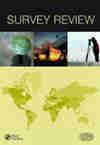基于互补系综经验模态分解和二次多项式的卫星短期时钟偏差预测
IF 1
4区 地球科学
Q3 ENGINEERING, CIVIL
引用次数: 2
摘要
卫星时钟偏差(SCB)的非线性和非平稳特性对SCB预报的准确性和稳定性产生了不利影响。为了消除非线性和非平稳性的影响,将互补集成经验模式分解(CEEMD)和二次多项式(QP)相结合,构建了一个混合预测模型,称为CEEMD-QP。首先,通过CEEMD将SCB序列分解为几个固有模函数(IMF)分量和一个残差项。其次,使用排列熵(PE)和相关系数来定量确定与原始SCB信号具有更多噪声和弱相关性的IMF分量。最后,利用IMF和残差分量重构SCB,并使用QP模型对时钟偏差进行拟合和预测。我们将IGS提供的GPS超快速精确SCB数据的观测部分用于预测实验。结果表明,CEEMD-QP方法在短期预测中具有明显的预测精度和稳定性优势。本文章由计算机程序翻译,如有差异,请以英文原文为准。
Short-term satellite clock bias forecast based on complementary ensemble empirical mode decomposition and quadratic polynomial
The nonlinear and nonstationary characteristics of satellite clock bias (SCB) have a harmful effect on the accuracy and stability of SCB forecast. To eliminate the influence of nonlinearity and non-stationarity, a hybrid forecast model was constructed that combines complementary ensemble empirical mode decomposition (CEEMD) and quadratic polynomial (QP), called CEEMD-QP. First, the SCB sequence is decomposed into several intrinsic mode function (IMF) components and one residual term by CEEMD. Second, permutation entropy (PE) and the correlation coefficient are used to quantitatively determine the IMF component with more noise and weak correlation with the original SCB signal. Finally, the SCB is reconstructed with the IMFs and residual components, and QP model is used to fit and forecast the clock bias. We adapt the observation part of ultra-rapid precise SCB data of GPS provided by IGS to forecast experiments. The results show that the CEEMD-QP method has obvious advantages of forecast accuracy and stability in short-term forecast.
求助全文
通过发布文献求助,成功后即可免费获取论文全文。
去求助
来源期刊

Survey Review
地学-地球科学综合
CiteScore
3.50
自引率
6.20%
发文量
33
审稿时长
6 months
期刊介绍:
Survey Review is an international journal that has been published since 1931, until recently under the auspices of the Commonwealth Association of Surveying and Land Economy (CASLE). The journal is now published for Survey Review Ltd and brings together research, theory and practice of positioning and measurement, engineering surveying, cadastre and land management, and spatial information management.
All papers are peer reviewed and are drawn from an international community, including government, private industry and academia. Survey Review is invaluable to practitioners, academics, researchers and students who are anxious to maintain their currency of knowledge in a rapidly developing field.
 求助内容:
求助内容: 应助结果提醒方式:
应助结果提醒方式:


